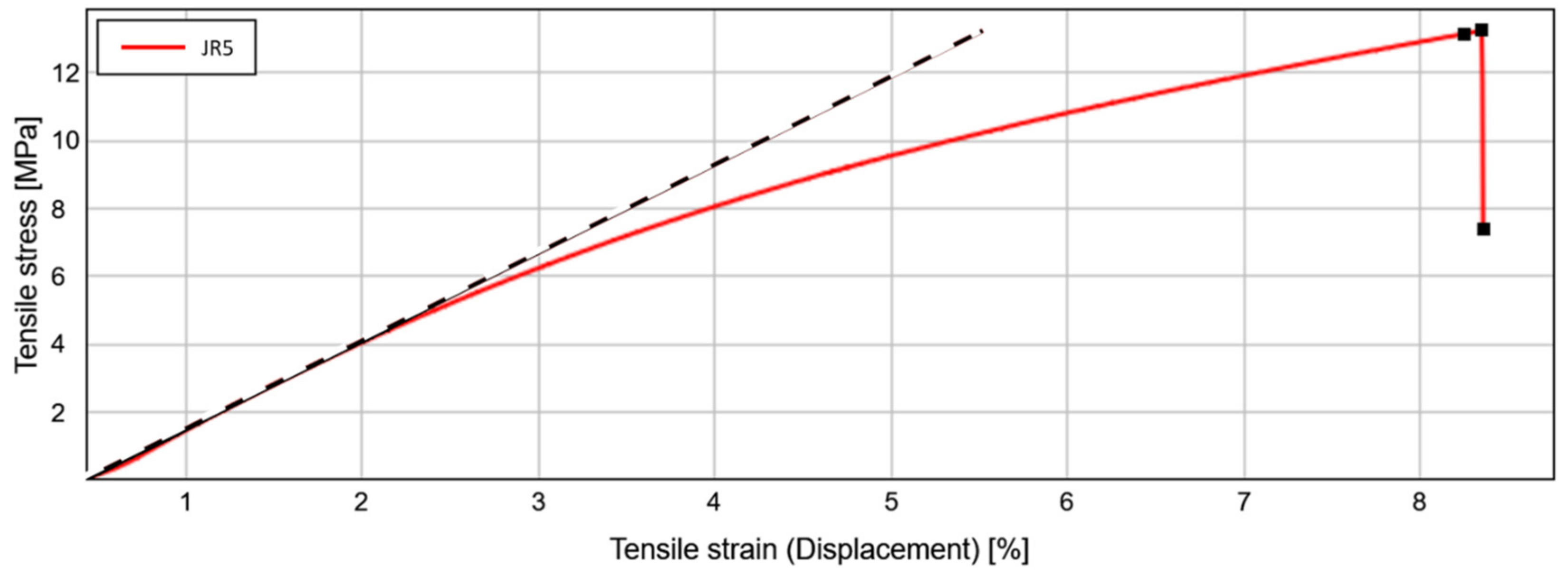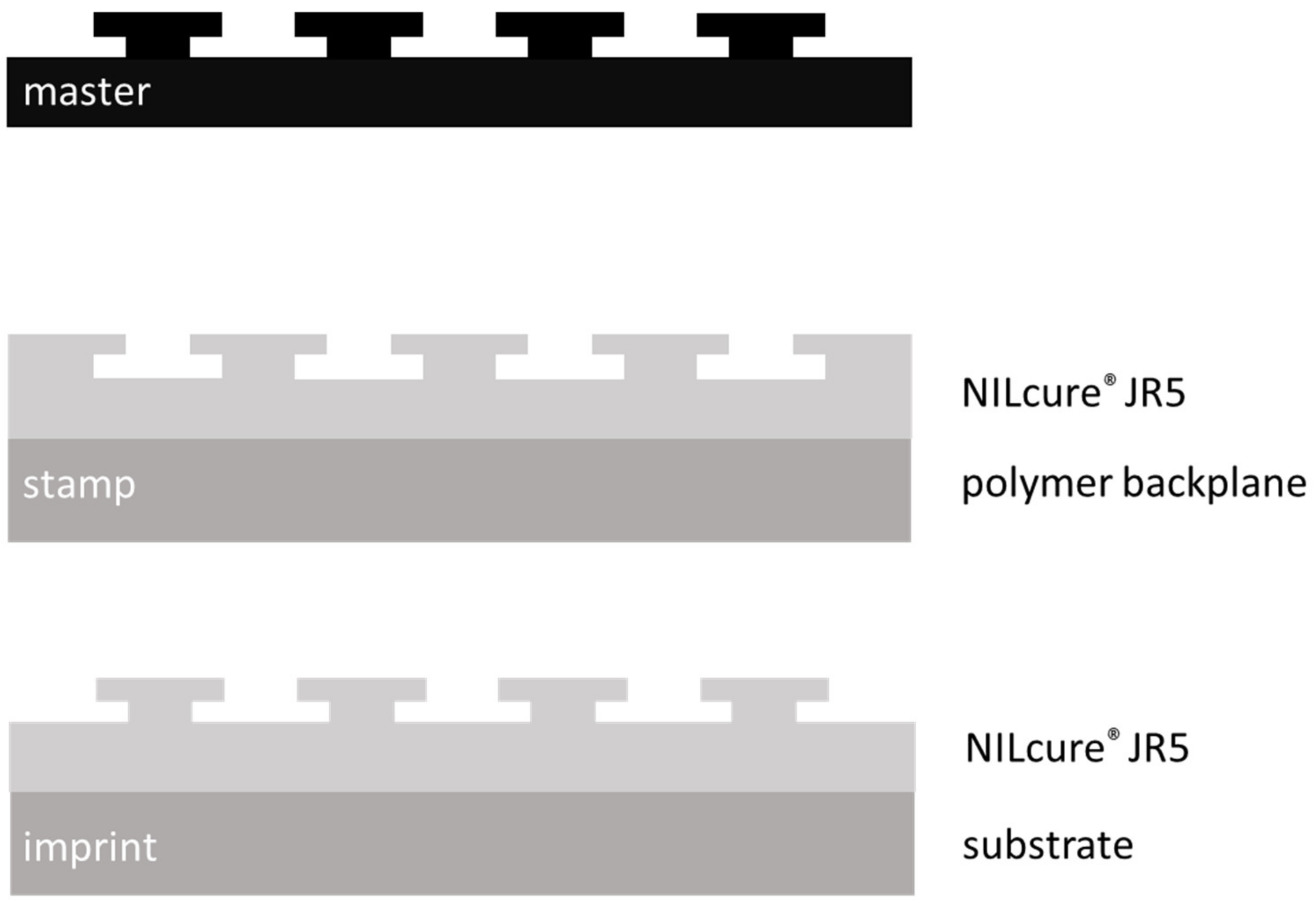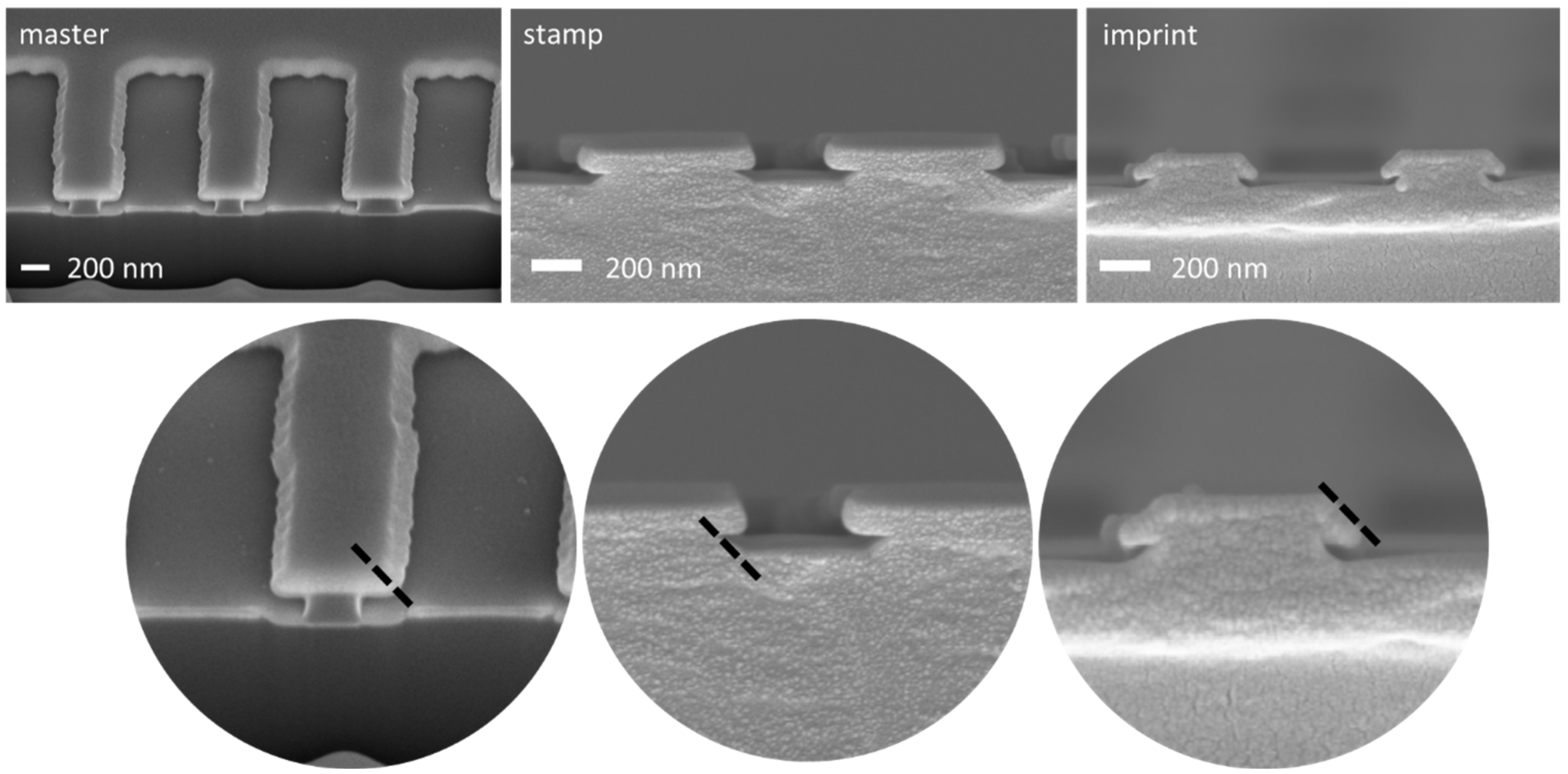Nanoimprint Replication of Biomimetic, Multilevel Undercut Nanostructures
Abstract
1. Introduction
2. Materials and Methods
2.1. Master Design and Fabrication
2.2. Nanoimprint Material
2.3. Nanoimprint Process
2.4. Sample Characterisation
3. Results
3.1. Single Layer Undercut Structures
3.2. Mulitlayer Undercut Structues
4. Discussion
Author Contributions
Funding
Data Availability Statement
Acknowledgments
Conflicts of Interest
References
- Mühlberger, M.; Rohn, M.; Danzberger, J.; Sonntag, E.; Rank, A.; Schumm, L.; Kirchner, R.; Forsich, C.; Gorb, S.; Einwögerer, B.; et al. UV-NIL fabricated bio-inspired inlays for injection molding to influence the friction behavior of ceramic surfaces. Microelectron. Eng. 2015, 141, 140–144. [Google Scholar] [CrossRef]
- Baum, M.J.; Heepe, L.; Fadeeva, E.; Gorb, S.N. Dry friction of microstructured polymer surfaces inspired by snake skin. Beilstein J. Nanotechnol. 2014, 5, 1091–1103. [Google Scholar] [CrossRef] [PubMed]
- Filippov, A.E.; Gorb, S.N. Modelling of the frictional behaviour of the snake skin covered by anisotropic surface nanostructures. Sci. Rep. 2016, 6, 23539. [Google Scholar] [CrossRef] [PubMed]
- Comanns, P.; Effertz, C.; Hischen, F.; Staudt, K.; Böhme, W.; Baumgartner, W. Moisture harvesting and water transport through specialized micro-structures on the integument of lizards. Beilstein J. Nanotechnol. 2011, 2, 204–214. [Google Scholar] [CrossRef]
- Buchberger, G.; Kogler, A.; Weth, A.; Baumgartner, R.; Comanns, P.; Bauer, S.; Baumgartner, W. “Fluidic diode” for passive unidirectional liquid transport bioinspired by the spermathecae of fleas. J. Bionic Eng. 2018, 15, 42–56. [Google Scholar] [CrossRef]
- Ivanova, E.P.; Hasan, J.; Webb, H.K.; Truong, V.K.; Watson, G.S.; Watson, J.A.; Baulin, V.A.; Pogodin, S.; Wang, J.Y.; Tobin, M.J.; et al. Natural Bactericidal Surfaces: Mechanical Rupture of Pseudomonas aeruginosa Cells by Cicada Wings. Small 2012, 8, 2489–2494. [Google Scholar] [CrossRef]
- Elbourne, A.; Crawford, R.J.; Ivanova, E.P. Nano-structured antimicrobial surfaces: From nature to synthetic analogues. J. Colloid Interface Sci. 2017, 508, 603–616. [Google Scholar] [CrossRef]
- Wilson, S.; Hutley, M. The Optical Properties of ’Moth Eye’ Antireflection Surfaces. Opt. Acta Int. J. Opt. 1982, 29, 993–1009. [Google Scholar] [CrossRef]
- Sun, J.; Wang, X.; Wu, J.; Jiang, C.; Shen, J.; Cooper, M.A.; Zheng, X.; Liu, Y.; Yang, Z.; Wu, D. Biomimetic Moth-eye Nanofabrication: Enhanced Antireflection with Superior Self-cleaning Characteristic. Sci. Rep. 2018, 8, 1–10. [Google Scholar] [CrossRef]
- Jacobo-Martín, A.; Rueda, M.; Hernández, J.J.; Navarro-Baena, I.; Monclús, M.A.; Molina-Aldareguia, J.M.; Rodríguez, I. Bioinspired antireflective flexible films with optimized mechanical resistance fabricated by roll to roll thermal nanoimprint. Sci. Rep. 2021, 11, 1–15. [Google Scholar] [CrossRef]
- McCoy, D.E.; McCoy, V.E.; Mandsberg, N.K.; Shneidman, A.V.; Aizenberg, J.; Prum, R.O.; Haig, D. Structurally assisted super black in colourful peacock spiders. Proc. R. Soc. B Boil. Sci. 2019, 286, 20190589. [Google Scholar] [CrossRef]
- Butt, H.; Yetisen, A.K.; Mistry, D.; Khan, S.A.; Hassan, M.U.; Yun, S.H. MorphoButterfly-Inspired Nanostructures. Adv. Opt. Mater. 2016, 4, 497–504. [Google Scholar] [CrossRef]
- Mason, C.W. Structural Colors in Feathers. I. J. Phys. Chem. 1923, 27, 201–251. [Google Scholar] [CrossRef]
- Mason, C.W. Structural Colors in Insects. I. J. Phys. Chem. 1926, 30, 383–395. [Google Scholar] [CrossRef]
- Forberich, K.; Dennler, G.; Scharber, M.C.; Hingerl, K.; Fromherz, T.; Brabec, C.J. Performance improvement of organic solar cells with moth eye anti-reflection coating. Thin Solid Films 2008, 516, 7167–7170. [Google Scholar] [CrossRef]
- Han, K.-S.; Shin, J.-H.; Yoon, W.-Y.; Lee, H. Enhanced performance of solar cells with anti-reflection layer fabricated by nano-imprint lithography. Sol. Energy Mater. Sol. Cells 2011, 95, 288–291. [Google Scholar] [CrossRef]
- Li, Q.; Zeng, Q.; Shi, L.; Zhang, X.; Zhang, K.-Q. Bio-inspired sensors based on photonic structures of Morpho butterfly wings: A review. J. Mater. Chem. C 2016, 4, 1752–1763. [Google Scholar] [CrossRef]
- Chou, S.Y.; Krauss, P.R.; Renstrom, P.J. Nanoimprint lithography. J. Vac. Sci. Technol. B Microelectron. Nanometer Struct. 1996, 14, 4129. [Google Scholar] [CrossRef]
- Haisma, J. Mold-assisted nanolithography: A process for reliable pattern replication. J. Vac. Sci. Technol. B Microelectron. Nanometer Struct. 1996, 14, 4124. [Google Scholar] [CrossRef]
- Schift, H. Nanoimprint lithography: An old story in modern times? A review. J. Vac. Sci. Technol. B Microelectron. Nanometer Struct. 2008, 26, 458. [Google Scholar] [CrossRef]
- Hua, F.; Sun, Y.; Gaur, A.; Meitl, M.A.; Bilhaut, L.; Rotkina, L.; Wang, J.; Geil, P.; Shim, M.; Rogers, J.A.; et al. Polymer Imprint Lithography with Molecular-Scale Resolution. Nano Lett. 2004, 4, 2467–2471. [Google Scholar] [CrossRef]
- Müehlberger, M.; Boehm, M.; Bergmair, I.; Chouiki, M.; Schoeftner, R.; Kreindl, G.; Kast, M.; Treiblmayr, D.; Glinsner, T.; Miller, R.; et al. Nanoimprint lithography from CHARPAN Tool exposed master stamps with 12.5 nm hp. Microelectron. Eng. 2011, 88, 2070–2073. [Google Scholar] [CrossRef]
- Reboud, V.; Obieta, I.; Bilbao, L.; Sáez-Martínez, V.; Brun, M.; Laulagnet, F.; Landis, S. Imprinted hydrogels for tunable hemispherical microlenses. Microelectron. Eng. 2013, 111, 189–192. [Google Scholar] [CrossRef]
- Landis, S.; Reboud, V.; Enot, T.; Vizioz, C. Three dimensional on 300mm wafer scale nano imprint lithography processes. Microelectron. Eng. 2013, 110, 198–203. [Google Scholar] [CrossRef]
- Leitgeb, M.; Nees, D.; Ruttloff, S.; Palfinger, U.; Götz, J.; Liska, R.; Belegratis, M.R.; Stadlober, B. Multilength Scale Patterning of Functional Layers by Roll-to-Roll Ultraviolet-Light-Assisted Nanoimprint Lithography. ACS Nano 2016, 10, 4926–4941. [Google Scholar] [CrossRef]
- Yde, L.; Lindvold, L.; Stensborg, J.; Voglhuber, T.; Außerhuber, H.; Wögerer, S.; Fischinger, T.; Mühlberger, M.; Hackl, W. Roll-to-Plate UV-Nanoimprinting for Micro and Nano-Optics. Available online: http://www.nntconf.org/submissions/rollerNIL%20NNT%20R2P%20v1.pdf (accessed on 28 August 2020).
- Moharana, A.R.; Außerhuber, H.M.; Mitteramskogler, T.; Haslinger, M.J.; Mühlberger, M.M. Multilayer Nanoimprinting to Create Hierarchical Stamp Masters for Nanoimprinting of Optical Micro- and Nanostructures. Coatings 2020, 10, 301. [Google Scholar] [CrossRef]
- Wanzenboeck, H.D.; Waid, S.; Bertagnolli, E.; Muehlberger, M.; Bergmair, I.; Schoeftner, R. Nanoimprint lithography stamp modification utilizing focused ion beams. J. Vac. Sci. Technol. B Microelectron. Nanometer Struct. 2009, 27, 2679. [Google Scholar] [CrossRef]
- Möllenbeck, S.; Bogdanski, N.; Wissen, M.; Scheer, H.-C.; Zajadacz, J.; Zimmer, K. Investigation of the separation of 3D-structures with undercuts. Microelectron. Eng. 2007, 84, 1007–1010. [Google Scholar] [CrossRef]
- Möllenbeck, S.; Bogdanski, N.; Scheer, H.-C.; Zajadacz, J.; Zimmer, K. Moulding of arrowhead structures. Microelectron. Eng. 2009, 86, 608–610. [Google Scholar] [CrossRef]
- Saito, A.; Miyamura, Y.; Ishikawa, Y.; Murase, J.; Akai-Kasaya, M.; Kuwahara, Y. Reproduction, mass production, and control of the Morpho butterfly’s blue. SPIE MOEMS-MEMS Micro Nanofabrication 2009, 7205, 720506. [Google Scholar] [CrossRef]
- Tabata, H.; Kumazawa, K.; Funakawa, M.; Takimoto, J.-I.; Akimoto, M. Microstructures and Optical Properties of Scales of Butterfly Wings. Opt. Rev. 1996, 3, 139–145. [Google Scholar] [CrossRef]
- Saito, A.; Ishibashi, K.; Ohga, J.; Kuwahara, Y. Morpho-Colored Flexible Film Fabricated by Simple Mass-Production Method; Knez, M., Lakhtakia, A., Martín-Palma, R.J., Eds.; International Society for Optics and Photonics: Portland, OR, USA, 2017. [Google Scholar]
- Saito, A.; Ishikawa, Y.; Miyamura, Y.; Akai-Kasaya, M.; Kuwahara, Y. Optimization of reproduced Morpho -blue coloration. Opt. East 2007, 2007, 676706. [Google Scholar]
- Taus, P.; Prinz, A.; Wanzenboeck, H.D.; Schuller, P.; Tsenov, A.; Schinnerl, M.; Shawrav, M.M.; Haslinger, M.; Muehlberger, M. Mastering of NIL Stamps with Undercut T-Shaped Features from Single Layer to Multilayer Stamps. Nanomaterials 2021, submitted. [Google Scholar]
- Choi, S.-J.; Kim, H.N.; Bae, W.G.; Suh, K.-Y. Modulus- and surface energy-tunable ultraviolet-curable polyurethane acrylate: Properties and applications. J. Mater. Chem. 2011, 21, 14325–14335. [Google Scholar] [CrossRef]
- Yoo, P.J.; Choi, S.-J.; Kim, J.H.; Suh, D.; Baek, S.J.; Kim, A.T.W.; Lee, H.H. Unconventional Patterning with A Modulus-Tunable Mold: From Imprinting to Microcontact Printing. Chem. Mater. 2004, 16, 5000–5005. [Google Scholar] [CrossRef]
- 3300 Series Universal Testing Systems up to 50, KN. Available online: http://www.instron.us/en-us/products/testing-systems/universal-testing-systems/low-force-universal-testing-systems/3300-series-universal-testing-systems-up-to-50-kn (accessed on 23 March 2021).
- Jastrzebski, Z.D. Nature and Properties of Engineering Materials; John Wiley & Sons: Hoboken, NJ, USA, 1977; ISBN 0-471-02859-2. [Google Scholar]
- Stauffer, C.E. The Measurement of Surface Tension by the Pendant Drop Technique. J. Phys. Chem. 1965, 69, 1933–1938. [Google Scholar] [CrossRef]
- Pendant Drop. Available online: http://www.kruss-scientific.com/en/know-how/glossary/pendant-drop (accessed on 23 March 2021).
- Krüss DROP SHAPE ANALYZER—DSA100. Available online: https://www.kruss-scientific.com/files/kruss-techdata-dsa100-en.pdf (accessed on 23 March 2021).
- Schmid, H.; Michel, B. Siloxane Polymers for High-Resolution, High-Accuracy Soft Lithography. Macromolecules 2000, 33, 3042–3049. [Google Scholar] [CrossRef]
- Fluorolink® MD700. Available online: https://www.solvay.com/en/product/fluorolink-md700 (accessed on 23 March 2021).
- OrmoComp®—Microresist. Available online: https://www.microresist.de/en/produkt/ormocomp/ (accessed on 23 March 2021).
- Profactor. ANTI STICKING LAYER BGL-GZ-83. Available online: https://www.profactor.at/en/solutions/coatings/ (accessed on 19 February 2021).
- Mühlberger, M.; Bergmair, I.; Klukowska, A.; Kolander, A.; Leichtfried, H.; Platzgummer, E.; Loeschner, H.; Ebm, C.; Grützner, G.; Schöftner, R. UV-NIL with working stamps made from Ormostamp. Microelectron. Eng. 2009, 86, 691–693. [Google Scholar] [CrossRef]
- Biostep. Available online: https://biostep.de/ (accessed on 24 February 2021).
- Profactor. HMNP-12—Adhesion Layer for Nanoimprint Materials. Available online: https://www.profactor.at/en/solutions/coatings/ (accessed on 19 February 2021).
- Coveme Treated and Stabilized Films—Kemafoil HSPL/HSPL W. Available online: https://www.coveme.com/hspl-w-high-surface-tension-film/ (accessed on 19 February 2021).
- COVEME BIOMEDICAL—Films for Biosensors in Near Patient Diagnostic. Available online: https://www.coveme.com/files/documenti/divisioni-brochure/brochure_biomedical_web.pdf (accessed on 19 February 2021).
- MELINEX® ST506. Available online: http://52.167.112.238/FilmEnterprise/Datasheet.asp?ID=271&Version=US (accessed on 19 February 2021).
- Fisher Scientific. Thermo ScientificTM SuperFrost Ultra PlusTM Adhäsionsobjektträger. Available online: https://www.fishersci.de/shop/products/superfrost-ultra-plus-adhesion-slides-3/10417002 (accessed on 19 February 2021).
- Boeckeler Instruments. Available online: https://www.boeckeler.com/company (accessed on 19 February 2021).








Publisher’s Note: MDPI stays neutral with regard to jurisdictional claims in published maps and institutional affiliations. |
© 2021 by the authors. Licensee MDPI, Basel, Switzerland. This article is an open access article distributed under the terms and conditions of the Creative Commons Attribution (CC BY) license (https://creativecommons.org/licenses/by/4.0/).
Share and Cite
Muehlberger, M.; Ruttloff, S.; Nees, D.; Moharana, A.; Belegratis, M.R.; Taus, P.; Kopp, S.; Wanzenboeck, H.D.; Prinz, A.; Fechtig, D. Nanoimprint Replication of Biomimetic, Multilevel Undercut Nanostructures. Nanomaterials 2021, 11, 1051. https://doi.org/10.3390/nano11041051
Muehlberger M, Ruttloff S, Nees D, Moharana A, Belegratis MR, Taus P, Kopp S, Wanzenboeck HD, Prinz A, Fechtig D. Nanoimprint Replication of Biomimetic, Multilevel Undercut Nanostructures. Nanomaterials. 2021; 11(4):1051. https://doi.org/10.3390/nano11041051
Chicago/Turabian StyleMuehlberger, Michael, Stephan Ruttloff, Dieter Nees, Amiya Moharana, Maria R. Belegratis, Philipp Taus, Sonja Kopp, Heinz D. Wanzenboeck, Adrian Prinz, and Daniel Fechtig. 2021. "Nanoimprint Replication of Biomimetic, Multilevel Undercut Nanostructures" Nanomaterials 11, no. 4: 1051. https://doi.org/10.3390/nano11041051
APA StyleMuehlberger, M., Ruttloff, S., Nees, D., Moharana, A., Belegratis, M. R., Taus, P., Kopp, S., Wanzenboeck, H. D., Prinz, A., & Fechtig, D. (2021). Nanoimprint Replication of Biomimetic, Multilevel Undercut Nanostructures. Nanomaterials, 11(4), 1051. https://doi.org/10.3390/nano11041051






